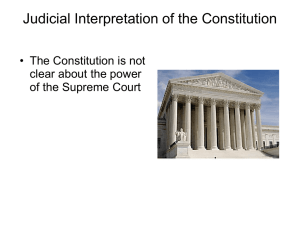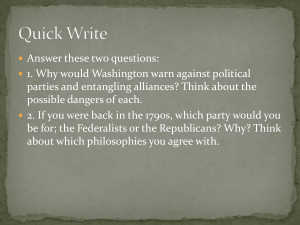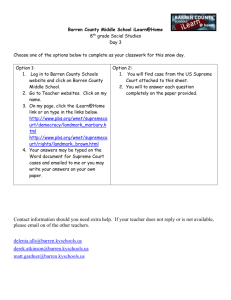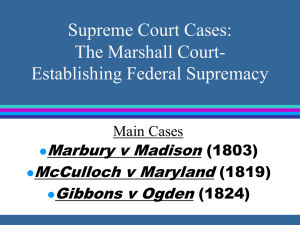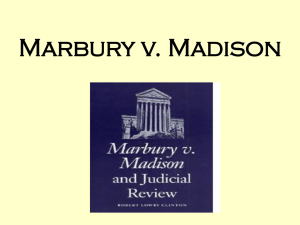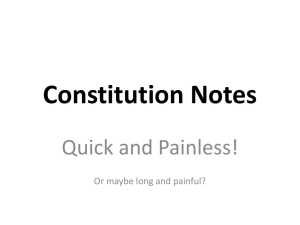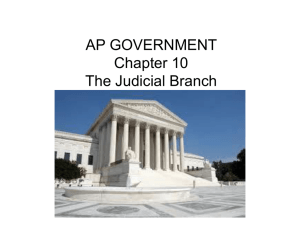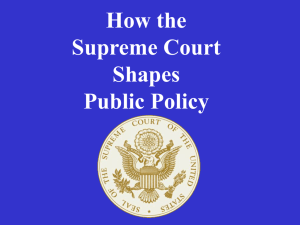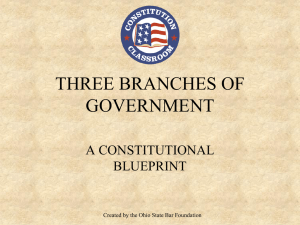MARBURY V. MADISON - Digital Chalkboard
advertisement
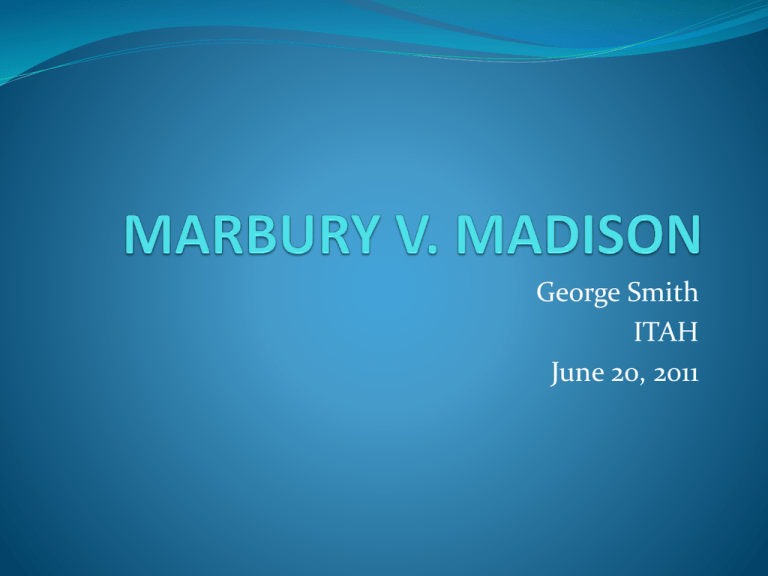
George Smith ITAH June 20, 2011 STANDARD: 11.1.3 Understand the history of the Constitution after 1787 with emphasis on federal versus state authority and growing democratization. OBJECTIVES To list the central issues in Marbury v. Madison and the significance of the Supreme Court’s ruling. To explain how Marbury v. Madison became the basis for judicial review in the American political system. Language Objectives Language Learners will be able to define the following terms: Significance American political system Central issues Federal authority What were the Alien and Sedition Acts? What were the differences between the Federalists and the Democrat-Republicans? Vocabulary! Judicial review Opinion Partisan politics Federalists Democrat-Republicans “midnight justices” Group Vocabulary Report In class groups define and explain the significance of each of the three vocabulary terms assigned to the group. Choose a group spokesperson who will report to the class. Adams v. Jefferson As a Federalist, Adams favored a stronger central government. Jefferson, a Democrat-Republican favored stronger states’ powers. In the election of 1800 each party tried to portray the other as “extreme”: Adams was called a “tool of the rich who wanted to turn the executive branch into a British style monarch”. (pg. 113) Jefferson was “a dangerous supporter of revolutionary France and an atheist”, according to the Federalists. (pg. 113) Central issues in Marbury v. Madison Adam’s “Midnight Justices” Just before Adams left office he appointed many Federalist to judgeships. One of these was William Marbury Marbury’s commission was not delivered to him before Adams left office. President Jefferson’s new secretary of state, James Madison, refused to give the commission to Marbury Central issues in Marbury v. Madison Marbury’s Claim William Marbury asked the Supreme Court to force Madison to give him his commission as a judge. Marbury’s reason for asking this was based on the Judiciary Act of 1789. John Marshall- 1st Chief Justice of the Supreme Court Painting by Rembrandt Peale Central issues in Marbury v. Madison The Supreme Court, in 1803, ruled that part of the Judiciary Act of 1789 was “unconstitutional”. Chief Justice Marshall wrote that since the Constitution is the “supreme law of the land, no law that goes against the Constitution can be valid.” This ruling established the concept of Judicial Review. Explain how Marbury v. Madison became the basis for Judicial Review Under what part of the Constitution did the Supreme Court derive its power of “Judicial Review”? Is “Judicial Review” even mentioned in the Constitution? In groups, students will analyze Article 3, Section 1 and 2 of the Constitution. Students may use the Internet to research the topic and read articles related to “Judicial Review”. …how Marbury v. Madison became the basis for Judicial Review http://www.lawnix.com/cases/marbury-madison.html http://supreme.lp.findlaw.com/supreme_court/landmark/marb ury.html http://www.historycentral.com/nn/marbury.html http://larivierelaw.org/famous_judicial_quotes.aspx The idea of judicial review established the Supreme Court’s importance as the 3rd co-equal branch of government. The American system of checks and balances ensures that the Judiciary is enabled to balance the other branches of government. Homework! Students will create a three-fold brochure that illustrates the concepts of the Power point lesson: Outside page: A picture and student and class information Inside pages: Left: List at least two of the central issues in Marbury v. Madison Middle: A brief description of ONE example of one other use of Judicial Review by the Supreme Court Right: A quote from John Marshall regarding the importance of Judicial Review. Sample Brochure Outside page: Marbury v. Madison and Judicial Review US History Mr. Smith by G Smith June 21, 2011 (Left side) William Marbury was denied his appointment to a judgeship, and appealed to the Supreme Court. His claim was based on the Judiciary Act of 1789. The Supreme Court ruled that part of the Judiciary Act was “unconstitutional”. This established the concept of “Judicial Review” by the Supreme Court. (Center) In City of Berne v. Flores (1997), the Supreme Court used Judicial Review to declare the Religious Freedom Restoration Act of 1993 to be unconstitutional. The Court ruled that Congress has no authority to interpret the Constitution. "It is emphatically the province and duty of the judicial department to say what the law is. Those who apply the rule to particular cases, must of necessity expound and interpret that rule. If two laws conflict with each other, the courts must decide on the operation of each." — Chief Justice John Marshall Bilbliography Danzer, Gerald A., et al. The Americans: Reconstruction to the 21st Century. Evanston, Il. 2006 Lawnix.com. 2009. Accessed June 20, 2011. <http://www.lawnix.com/cases/marbury-adison.html> FindLaw. Reuters Business, Inc. 2009. Accessed June 20, 2011. <http://supreme.lp.findlaw.com/supreme_court/landmark/marbury.ht ml> HistoryCentral.com. 2008. Multieducator, Inc. Accessed June 20, 2011. <http://www.historycentral.com/nn/marbury.html> Lavierrelaw.org. LaVierre, Jr, Maurice. Accessed June 21, 2011. <http://larivierelaw.org/famous_judicial_quotes.aspx>

